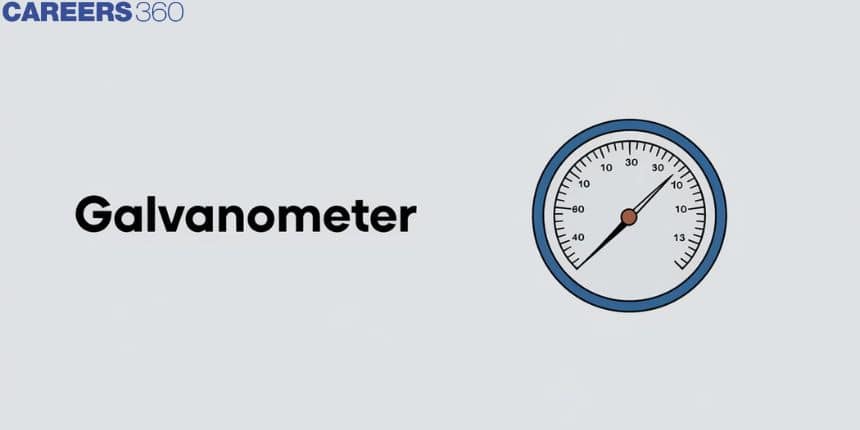Galvanometer
A galvanometer is an essential instrument in the world of electrical measurements, known for its ability to detect and measure small electric currents. It operates on the principle of electromagnetism, where a needle moves in response to an electric current passing through a coil. This delicate device forms the basis of more advanced instruments like ammeters and voltmeters. In real life, the principles of a galvanometer are at play every time you check the battery level of your remote control or smartphone, where the device measures the tiny current fluctuations to give you an accurate reading. Just as a compass needle aligns itself with the Earth’s magnetic field, a galvanometer’s needle aligns with the current's magnetic effect, providing a visual representation of the invisible flow of electricity. This makes it a crucial tool not only in laboratories but also in everyday technology
JEE Main/NEET 2027: Physics Important Formulas for Class 10
NEET 2025: Mock Test Series | Syllabus | High Scoring Topics | PYQs
JEE Main: Study Materials | High Scoring Topics | Preparation Guide
JEE Main: Syllabus | Sample Papers | Mock Tests | PYQs
- KCL, KVL, Conservation of Charge and Energy and Introduction to Galvanometer
- Solved Examples Based on Galvanometer
- Summary

KCL, KVL, Conservation of Charge and Energy and Introduction to Galvanometer
Kirchhoff's Current Law (KCL)
Kirchhoff's Current Law is a fundamental principle in electrical circuits that states the sum of all currents entering a junction in a circuit is equal to the sum of all currents leaving that junction. This is a direct consequence of the conservation of electric charge, implying that charge cannot accumulate at a point; it must flow in and out equally.
Kirchhoff's Voltage Law (KVL)
Kirchhoff's Voltage Law deals with the conservation of energy in electrical circuits. It states that the sum of the electromotive forces (emf) and potential differences (voltage drops) around any closed loop in a circuit is zero. This law is based on the principle that energy supplied by sources is equal to the energy consumed by components within the loop.
Conservation of Charge
The conservation of charge is a principle that states that the total electric charge in an isolated system remains constant over time. This means that charge cannot be created or destroyed but can only be transferred from one part of the system to another. This principle is foundational in understanding how electric circuits operate and is directly related to KCL.
Conservation of Energy
The conservation of energy principle asserts that the total energy in an isolated system remains constant, meaning energy cannot be created or destroyed but only transformed from one form to another. In electrical circuits, this principle is manifested through KVL, where the total energy provided by sources (like batteries) is equal to the energy consumed by resistive elements, inductors, and capacitors.
Introduction to Galvanometer
A galvanometer is a sensitive instrument used to detect and measure small electric currents. It operates on the principle of electromagnetism, where a needle moves in response to the magnetic field generated by the current passing through a coil. The galvanometer is a practical application of the laws of conservation of charge and energy, as it measures the flow of electric charge and the energy associated with it. In real-life scenarios, such as checking the functionality of batteries or ensuring proper circuit connections, the principles of the galvanometer come into play, illustrating the direct application of these fundamental laws.
Examples of types of galvanometers are
1. moving coil galvanometer
2. moving magnet galvanometer
Recommended Topic Video
Solved Examples Based on Galvanometer
Example 1: The thermo e.m.f. of a thermocouple is
1)
2)
3)
4)
Solution:
Galvanometer
It is an instrument used to detect small currents passing through it by showing deflection.
Let the smallest be
The potential difference across galvanometer
Hence, the answer is the option (1).
Example 2: The value of the current i1 flowing from A to C in the circuit diagram is:
1) 2 A
2) 4 A
3) 1 A
4) 5 A
Solution:
Voltage across
Hence, the answer is the option (1).
Example 3: A galvanometer of resistance G is converted into a voltmeter of range
1)
2)
3)
4)
Solution:


Divide (1) by (2)
Hence, the answer is the option (4).
Example 4: A
1) 45
2) 47
3) 49
4) 51
Solution:

Each side will be of resistance
Potential drop across diagonal
Hence, the answer is the option (1).
Example 5: For the circuit shown, the value of current at time t = 3.2 s will be ______ A.
[Voltage distribution V(t) is shown by Fig. (1) and the circuit is shown in Fig. (2)]
1) 1
2) 2
3) 3
4) 4
Solution:
Hence, the answer is the option (1).
Summary
A galvanometer is a device for detecting or measuring electric currents that tend to be small either in a circuit or flowing through it due to the operation. It operates on the idea that if an electric current flows through a coil, it will generate a magnetic field around it making a needle or pointer move. Such movement in turn tells us about the presence and direction of the current. They are very sensitive hence capable of measuring tiny amounts of current accurately.
Also Read
29 Nov'24 09:48 AM
23 Nov'24 01:56 PM
20 Nov'24 10:32 AM
17 Nov'24 10:02 AM
17 Nov'24 09:56 AM
14 Nov'24 07:31 PM
14 Nov'24 05:59 PM
14 Nov'24 01:16 PM
14 Nov'24 12:54 PM



